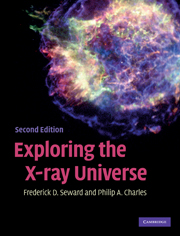Book contents
- Frontmatter
- Contents
- List of acronyms
- Foreword
- Chapter 1 Birth and childhood of X-ray astronomy
- Chapter 2 X-ray emission and interaction with matter
- Chapter 3 Tools and techniques
- Chapter 4 Solar system X-rays
- Chapter 5 X-ray absorption and scattering in the Interstellar Medium
- Chapter 6 Active stellar coronae
- Chapter 7 Early-type stars
- Chapter 8 Supernova explosions and their remnants
- Chapter 9 Neutron stars, pulsars, pulsar wind nebulae, and more supernova remnants
- Chapter 10 Cataclysmic variable stars
- Chapter 11 X-ray binaries
- Chapter 12 Black-hole X-ray binaries
- Chapter 13 Normal and starburst galaxies
- Chapter 14 Active galactic nuclei
- Chapter 15 Clusters of galaxies
- Chapter 16 The diffuse X-ray background
- Chapter 17 Gamma-ray bursts
- Index
- Plate section
Chapter 7 - Early-type stars
Published online by Cambridge University Press: 05 June 2012
- Frontmatter
- Contents
- List of acronyms
- Foreword
- Chapter 1 Birth and childhood of X-ray astronomy
- Chapter 2 X-ray emission and interaction with matter
- Chapter 3 Tools and techniques
- Chapter 4 Solar system X-rays
- Chapter 5 X-ray absorption and scattering in the Interstellar Medium
- Chapter 6 Active stellar coronae
- Chapter 7 Early-type stars
- Chapter 8 Supernova explosions and their remnants
- Chapter 9 Neutron stars, pulsars, pulsar wind nebulae, and more supernova remnants
- Chapter 10 Cataclysmic variable stars
- Chapter 11 X-ray binaries
- Chapter 12 Black-hole X-ray binaries
- Chapter 13 Normal and starburst galaxies
- Chapter 14 Active galactic nuclei
- Chapter 15 Clusters of galaxies
- Chapter 16 The diffuse X-ray background
- Chapter 17 Gamma-ray bursts
- Index
- Plate section
Summary
O stars
The most luminous, most massive stars are the O stars. Starting with more than 25 M⊗ of material (possibly ~100 M⊗), they burn their nuclear fuel at a prodigious rate. They live only a short time and end in a brilliant supernova explosion. The surrounding space is left full of stellar debris enriched in heavy elements. Our bodies all contain elements made in these massive stars.
These are not common stars, and none are nearby. The brightest ones visible to the naked eye are δ and ζ Orionis at the two ends of Orion's Belt. Both are 1600 pc distant and spectral type O9.5; ζ Puppis is 2400 pc distant and type O5. Because the nuclear fuel is consumed rapidly, the lifetime is, astronomically speaking, short. In a few million years an O star changes character, becoming perhaps a red giant or a Wolf-Rayet star. We see, with naked eye or telescope, only the outer layer, which gives little information about events in the core. Hidden from view, the central region evolves rapidly until the nuclear fuel is exhausted. As explained in Chapter 8 on supernova remnants, the core collapses and the gravitational energy released powers the resulting supernova. That is the end of the O star.
Astronomers originally believed all stars evolved along the main sequence. In this scheme a star would start life as a hot O star and, as it aged, would change into progressively cooler spectral types.
- Type
- Chapter
- Information
- Exploring the X-ray Universe , pp. 84 - 96Publisher: Cambridge University PressPrint publication year: 2010



